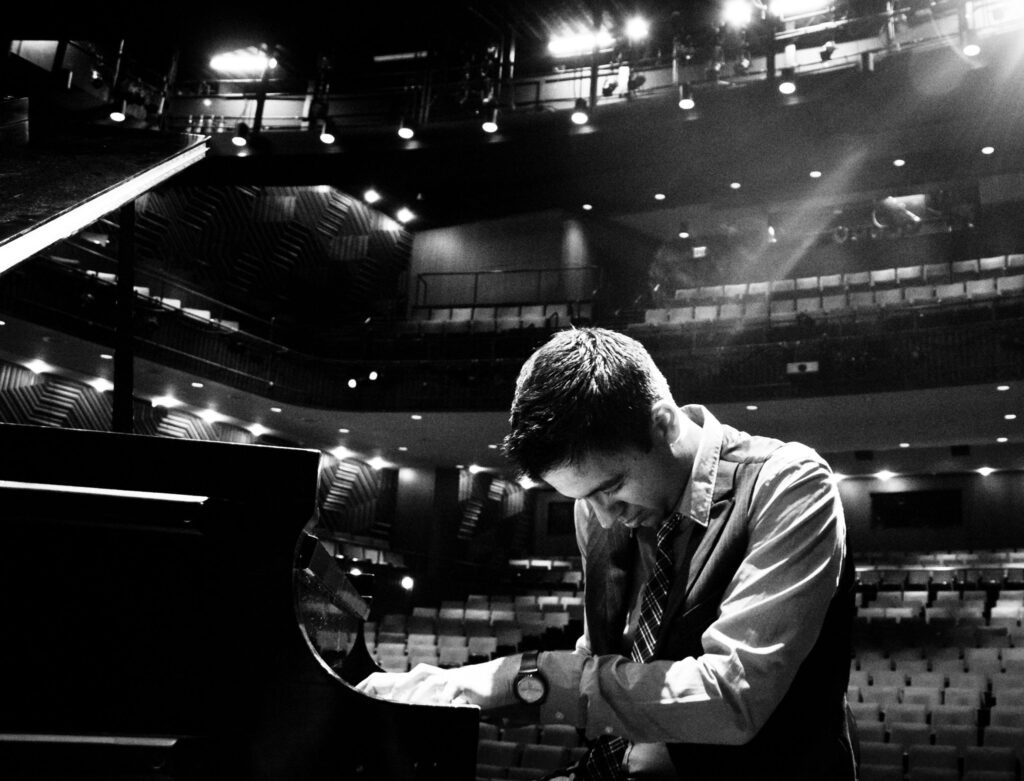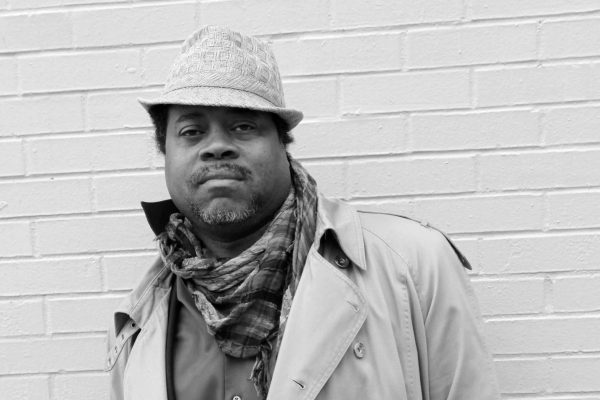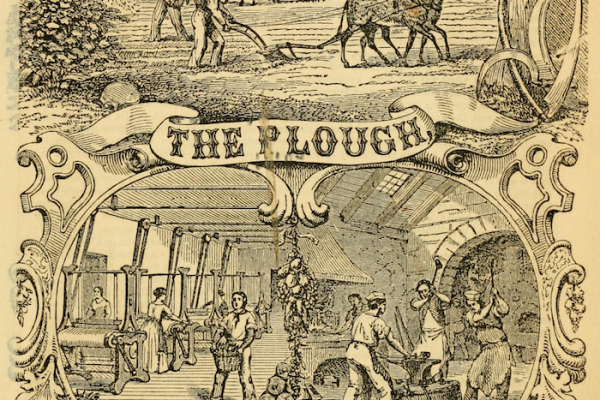Vijay Iyer wears many hats. Pianist, composer, scholar, public intellectual, and artist, he is a recipient of a MacArthur genius grant and holds the Franklin D. and Florence Rosenblatt Professor of the Arts at Harvard University. His work is deeply rooted in black musical traditions, though he also draws on his own South Asian heritage, European concert music, experimentalism, and an array of influences across time and space. He has worked with artists across many genres, including George Lewis, Wadada Leo Smith, Roscoe Mitchell, Steve Coleman, Miya Masaoka, Imani Uzuri, Jennifer Koh, Rez Abbasi, Greg Tate’s Burnt Sugar, poets such as Mike Ladd and the late Amiri Baraka, and the hip hop group Das Racist. In the course of twenty-five years, Iyer put out at least twenty-one albums as a leader, most recently Mutations (with a string quartet), a trio recording titled Break Stuff, duo recordings with trumpeter Wadada Leo Smith (A Cosmic Rhythm with Each Stroke) and pianist Craig Taborn (The Transitory Poems), and Far From Over with his sextet. And he collaborated with filmmaker Prashant Bhargava on the spectacular multimedia work Radhe Radhe: Rites of Holi.
Vijay’s refusal to treat music as a set of bounded cultural traditions, not to mention his name and brown skin, often led critics to listen for ‘Indianness’ in everything he did.
I first met Vijay in the late 1990s, not long after he relocated from the Bay Area to New York City. We were all part of the Jazz Study Group, a small assemblage of writers, artists, scholars, and musicians that gathered every couple of months at Columbia University to discuss the music from an interdisciplinary perspective. Vijay certainly stood out, having left California with a PhD in music and cognitive science from the University of California, Berkeley, and a unique musical and political experience as part of the Asian Improv Arts movement founded by pianist Jon Jang and saxophonist Francis Wong, radical musicians anchored in black music, Asian-Pacific diasporic traditions, and a revolutionary commitment to social justice. Vijay brought to the New York music scene an unusual level of innovation and openness, but his refusal to treat music as a set of bounded, discrete cultural traditions, not to mention his name and brown skin, often led critics to listen for “Indianness” in everything he did. But he and many of his contemporaries pushed against all of these boundaries, and they pushed against the racism within the industry that not only pigeonholed artists but limited their ability to make a living. To this end he cofounded the short-lived Creative Musicians Alliance in 2001, which we discuss below.
We began talking about the limits of the term “ally” and what it might signify in the world of music marketed broadly as “jazz”—a music where proximity to blackness often determines its perceived authenticity. We then opened up to a set of larger questions about how improvised ensemble music might be connected to the practice of making alliances and doing a certain kind of political work. Vijay came up with the title for the interview to underscore his main point that we ought to think of “ally” as a verb, as the action with which we must engage to dismantle all systems of oppression. He was also referencing Amiri Baraka’s Blues People where he wrote that turning “Swing” from “verb to noun” erased the agency and inventiveness of black people, as well as poet Nathaniel Mackey’s elaboration on Baraka in his classic 1992 essay, “Other: From Noun to Verb.” He sent me the title in a text just minutes after we parted—somewhat spontaneously, somewhat in jest. And yet, it perfectly encapsulated his approach to life and art: ally is not a distinct social category requiring recognition, it is what you do with others to push back the storm and create space for genuine freedom.
— Robin D. G. Kelley
Robin D. G. Kelley: The word “ally” is often used to identify those who are supportive of other’s struggles, and it’s a word that has had a lot of currency in the era of Black Lives Matter and Occupy. What would you say the term means to you, especially in the context of making music?
Vijay Iyer: That’s a really profound and profoundly American question. I’ve been advising a student—by his own account, a privileged white kid from the South—who’s doing a project on Thomas Dorsey and Rosetta Tharpe, who were iconic innovators of gospel music. For the project, he’s writing about them, but then with an ensemble he’s also to present his own versions of some of the music that made them famous. And he’s been having a crisis around, basically, “Who am I in relation to all of this?”
My conversations with him have brought me to reflect about how blackness in the arts has a caché: it’s cool to seem black, right? I’ve even noticed that on social media, when I post a photo of myself standing next to a black person—literally any black person—it gets more likes than if I just post a picture of myself.
I think many people think I’m cool because of my proximity to blackness—but also because I’m not actually black, you know? And that’s inextricable from the history of black music in the United States being sold by white companies and appropriated by non-black people, or inhabited in different ways by non-black people, which is this sort of way of managing and selling proximity to blackness without the guilt.
But for me, that just can’t be the point, right? That’s basically what I told my student: “This has to be about what you’re doing for people’s liberation, not what are you doing to gain some kind of status or currency.” You know, Martin Luther King, Jr.’s famous challenge: What are you doing for others? That’s the question I pose to myself in every context. This can’t just be about me sounding cool or looking awesome. It has to be in service of something larger. You want to actually open a conversation and activate people’s imaginations, and allow them to imagine a different world than the one we’re in. And that’s the kind of work that an artist can do, because we’re not there to answer questions exactly. We’re there to stir something up, and also to offer an alternative to the reality that we’re inhabiting.
This summer we were playing at Village Vanguard in Manhattan for a week, and the first night we got up there, it was a full house, and I just started by saying: “Let me get this out of the way. Trump sucks.” Because I was thinking about how these venues are rooms in which people from very different backgrounds find themselves thrown together. That’s amplified in historic venues such as that, where the space in its heyday was a room where white people would come listen to black musicians. And maybe feel a little edgy by doing that—I mean, it’s called Village Vanguard. But then what’s the next step beyond sitting next to it? Or sitting and looking at it? Do you ever feel mobilized by it?
I try to keep in mind that music that is doing political work is not the same as a political work of music. I’m not saying that the moment where I just said “Trump sucks” is an example of that, exactly—it’s more a question of what are you enacting in the act of being together and creating together. And the kind of agency you afford each other, the way you listen to each other. And maybe the diversity that you might represent as an ensemble.
RK: Can you talk about that? What is required to make music in an ensemble and are there political implications to this work? What does it do to you, and for you?
VI: I have learned that being in these kinds of aggregates is implicitly to take up the charge of challenging white dominance. And really, when you look at the history of the music, even music that wasn’t ostensibly political like Art Blakey and the Jazz Messengers, that was almost always, for decades, a group of black men making music together. And Blakey, for example, had a sense of responsibility to nurture young people like himself, to enlist them, and just let them apprentice to a certain reality. That’s community work to me, even if it goes by a different name. And it wasn’t like he was writing or featuring songs with political titles or something, but it’s sort of enacting a sense of, “This is a space for us.”
‘I want my music to actually open a conversation and allow people to imagine a different world than the one we’re in.’
I’ve also often found myself in spaces that were basically black spaces: black men, and then me. So what did that mean for me? Who was I in relation to all that? But it’s often a certain kind of mutual leap of imagination: “OK, I think that’s something we can do together.” Whatever our differences might be in terms of heritage, and cultural awareness, and generation, and all that. There’s a sense we’re in a certain struggle together. I was in Amiri Baraka’s band at the Dodge Poetry Festival when he performed “Somebody Blew Up America,” which led to him being stripped of the title of Poet Laureate of New Jersey—or rather, it wasn’t just revoked from him, but revoked from existence. There was no longer ever going to be a poet laureate in New Jersey because of that. We were literally the only non-white people anywhere. I remember we were hanging out backstage, and when it was time for us to play, Baraka comes around and says, “OK, all the Negroes and one Indian please report to the stage.” That was the kind of thing he could do: he just named what we were all experiencing, like, “This is this hypervisibility that we’re all experiencing in this context.”
RK: But is that, for you, allyship? Or is it something else?
VI: You know, I am really cautious around words like that: these nouns that become freighted with people’s agendas. Because I don’t know what somebody wants that word to mean when I say it. I’m the same with the word jazz. It’s too many competing agendas around one noun. I think it’s more productive to deal in verbs: How do we do work together toward a common purpose?
RK: Right. To ally.
VI: Yes. And then, who am I in relation to that larger purpose? And especially as someone who is something of an outsider, but also a non-white, non-black outsider. Because in much the way that blackness occupies a certain place in the white imagination, South Asian culture was very prominent in the black imagination as well. King is a prime example: he was inspired by tactics that Gandhi cultivated, and that was a huge point of reference for him in the civil rights movement, which then changed the world.
‘Words like allyship become freighted with people’s agendas. I don’t know what somebody wants that word to mean when I say it.’
But the Coltranes also made all these musical gestures to “the East,” as it was called. In John Coltrane’s version of “My Favorite Things,” everything’s stripped down to a drone. And then Alice Coltrane Turiyasangitananda took that sensibility much further and actually immersed herself in Indian spiritual practice. You can probably locate this historically better than I can, but I attribute it in part to the post–World War II black experience of coming home and realizing that you’re actually not welcome, and then starting to rethink your investment in all kinds of European culture, including Christianity. So another manifestation of that is people looking to Islam, or searching for a sense of common cause with the rest of the Third World.
And so a particular brand of allyship emerges out of black people looking outside the West for other examples of how to be. And also realizing that there’s a common cause there, a common struggle. But then what are people like me in that context? My parents came to the United States in the mid-sixties from India because of the change in immigration laws that allowed for an influx of people with technical and scientific educations. So that’s very different than people who were descended from the enslaved. When people say we’re a nation of immigrants, those kinds of important distinctions get elided. That said, we still came from a postcolonial landscape.
RK: The African American–South Asian connection went both ways, too. The Dalit Black Panthers, for example. And I don’t think it’s an accident that the particular variant of Islam that really took off among musicians was the Ahmadiyya movement, which begins with a South Asian Muslim. I want to go back though to talk about how you’ve worked with a lot of multiracial formations—when we first met, you were very involved with Asian Improv.
VI: When I was in the Bay Area in the nineties, I encountered that whole community—Francis Wong, Jon Jang, Anthony Brown, Miya Masaoka, Mark Izu, Brenda Wong Aoki, Hafez Modirzadeh—and the cultural work they were doing was critical to a particular moment in what we could call the trajectory of Asian American identity formation. They were doing a particular kind of work that was centered around community organizing, and music as an aspect of that, and it was part of a communist sensibility, actually. A lot of them were labor organizers, in fact.
It was very powerful in that setting to see that you could basically be yourself. Like, you could even mention or address your own ethnicity while being allied with the new civil rights movement. And that community gave me some of my first opportunities. The Asian American jazz festival, which Asian Improv organized, gave me some of my first major gigs as a leader. I remember we had this large group that I called Brotherhood of the Diaspora. It was a pan-ethnic kind of thing, based in the idea that we could somehow find a common cause. We could do something together, we could ally around something.
That brings us back to the idea of ally as verb, which means it doesn’t become an identity. Instead it’s a purpose, or a task.
RK: Exactly. A praxis, the application of theory toward changing society. I remember hearing you talk fifteen or twenty years ago about the Creative Musicians Alliance you cofounded with Miya Masaoka, Aaron Stewart, and Reggie Workman. And you were very motivated by this idea of creating a collective, and how a collective might increase collaboration across race and ethnic divisions, which could in turn shape the culture of the music industry to respect difference without defining artists by it. What ended up happening with that organization?
VI: Well, we were a bit scattered and it was in my early years in New York City. It’s very difficult to sustain collective sensibility there because the city has a way of forcing you into survival mode. So I think that particular aggregate was one such casualty. We were very inspired by the Association for the Advancement of Creative Musicians and the Black Artists Group, which aimed to uplift innovative work by artists of color, period. And you wouldn’t believe how hard that is to find organizations that does that. I mean, jazz is a space in which that supposedly happens, but as we said earlier, jazz is really a space that sells proximity to blackness to white people.
And so because of that, it’s always this peculiar, fetishistic, fraught dynamic. And that’s why people push back on the label “jazz,” and initiated this other language of the creative music movement, basically claiming a mobility and artistic self-determination. Because what I also found is that we artists of color in general, and particularly in that moment (late-1990s, early 2000s), were often expected to perform tradition. No matter who you were, or where you were from, if you weren’t white then you had to somehow be a folk musician. Channel the ancient ways of your people, you know? It’s like: “Can I comment on modernity just like you all do every damn day? We have something to say about this.” The projects that I ended up doing with Mike Ladd were speaking to that. They were about people of color claiming the right to comment on the contemporary predicament.
RK: Have things changed since then?
VI: Well, I think what’s changed is that we’ve done it. We’ve set out this path that no longer seems extraordinary. And not just me, but a lot of us have reclaimed that right to invent. It’s hard to express how much opposition we faced back then. Back then it was actually like, “What makes you think you belong here?” I still encounter vestiges of it here and there, but I also enjoy a certain freedom because I’ve done all these things and acquired a certain reputation. So then the responsibility, as Toni Morrison said, is to free someone else.
RK: So what’s next for you? You are committed to making this place better than we found it, as James Baldwin might say. What’s next for you in terms of your creative projects and your attempts to do the politics of making music?
VI: Well, one intriguing thing that’s happened to me in the last ten or fifteen years is that I have acquired a certain profile in the Western classical music world, which is the whitest place. Audiences you encounter there are old, and white, and rich. I don’t know how long this is going to last, but I get invited to comment in these spaces on the Western tradition—one project, for example, Radhe Radhe: Rites of Holi, I worked with Prashant Bhargava on kind of rethinking Stravinsky’s Rite of Spring. So I try to use those as moments to literally address the powerful.
‘The Western classical music world is the whitest place. Audiences you encounter there are old, and white, and rich.’
Columbia University is doing an interdisciplinary project called “The Year of Water” and invited me to present a program at its Miller Theatre, which is an opportunity not often afforded to non-white composers. I guess it’s a way of drawing the different disciplines together to think about resources and climate change. And so I’m giving the money to Flint. Because this program will be presented to a room of 800 white people and I’ll get to say to them: “Look, there’s this thing called environmental racism. When we talk about water and our increasingly precarious relationship to basic resources, we can also think about how resources are unevenly distributed by those in power, and also about how the powerful will negligently do harm to entire populations. And so this is an example of that.” So basically giving them the language to understand that, that’s basically what I feel like I can do in that moment, with people who might otherwise never see me again, but in that moment you get try to make them feel a certain way that might stay with them.
I’m also doing a project with Eve Ewing for the University of Chicago, which commissioned me to do a project about Chicago. Her work talks about systematic defunding of public schools in Chicago. And I just wanted to tap into that history. And she’s somebody who has this archival rigor in dealing with history, her 1919 project being a prime example. So I’m really excited about that, that’s in May 2020.
RK: That’s amazing. Well Vijay, keep doing it.
VI: Thank you, Robin. Also, you keep doing it.






